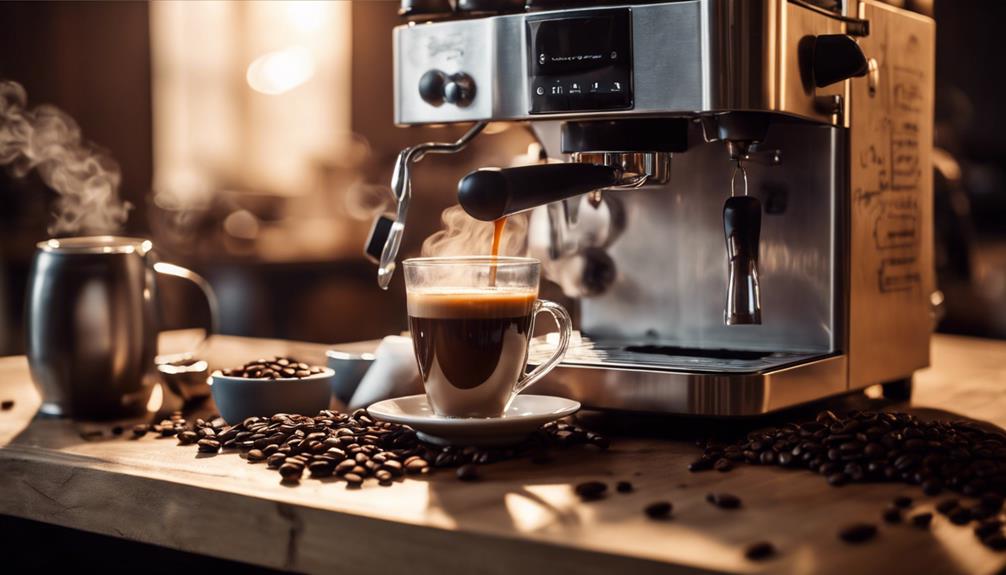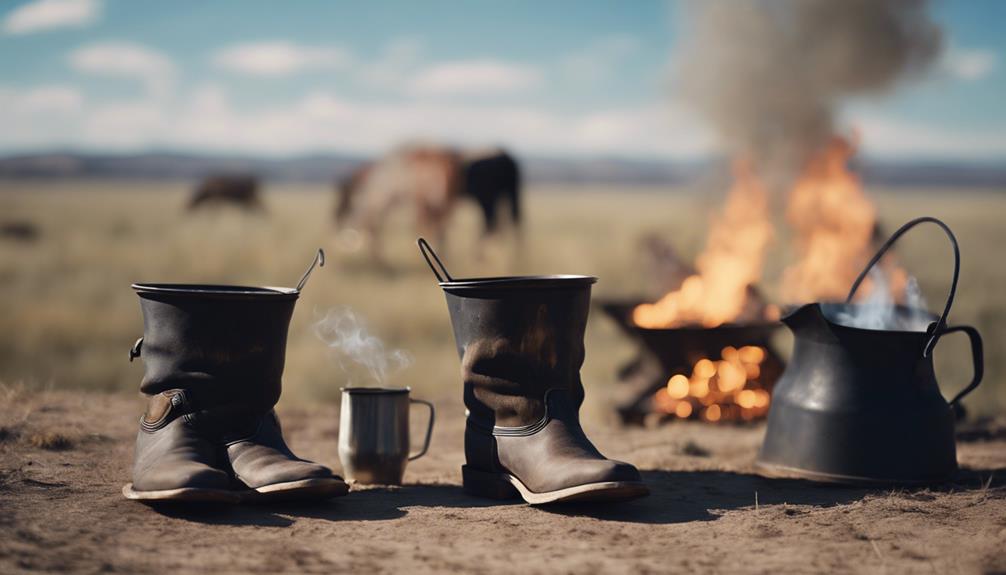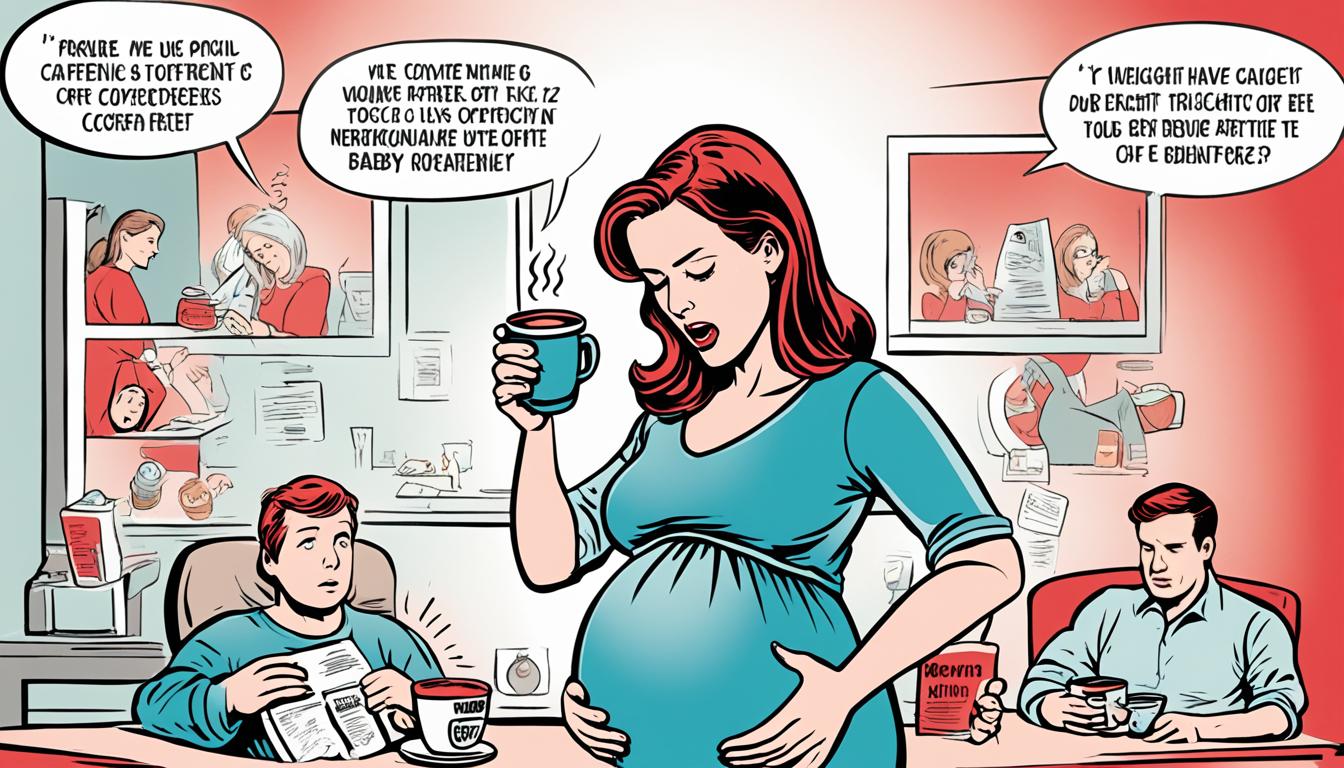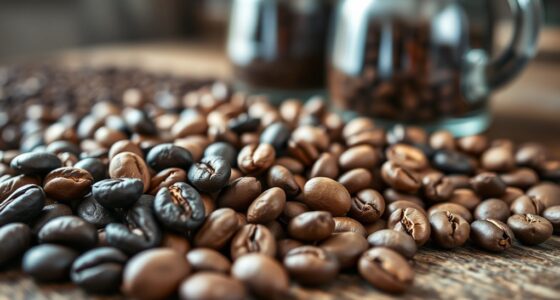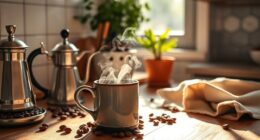In a typical 8-ounce cup of brewed coffee, you can expect to find 70 to 140 mg of caffeine. A single ounce espresso shot contains around 63 mg of caffeine, while a double shot has about 126 mg. Instant coffee varies greatly, ranging from 30 to 90 mg per 8-ounce cup. Decaf coffee typically only has around 2 mg of caffeine per 8-ounce serving, as it eliminates at least 97% of the caffeine. Various factors such as the type of beans (Arabica vs. Robusta), the roast level, and the brewing method all influence the level of caffeine in your coffee. Knowing this information can help you make more informed decisions about your caffeine consumption, but there is still much more to learn about these factors.
Key Takeaways
- Brewed coffee typically contains between 70 to 140 mg of caffeine in an 8 oz cup.
- Espresso offers about 63 mg of caffeine per 1-ounce shot.
- Instant coffee ranges from 30 to 90 mg of caffeine per 8 oz cup.
- Decaf coffee contains approximately 2 mg of caffeine per 8 oz cup.
- Factors like bean type, roast style, and brewing methods affect caffeine levels.
Brewed Coffee
When you pour yourself an 8 oz cup of brewed coffee, you're getting anywhere from 70 to 140 mg of caffeine. The amount of caffeine in your cup of coffee can vary substantially based on several factors.
The type of beans used plays an essential role; for instance, Arabica beans generally contain less caffeine than Robusta beans. Additionally, the roast style impacts the caffeine content. Contrary to popular belief, darker roasts have slightly less caffeine than lighter roasts because some caffeine is lost during the roasting process.
Brewing methods also influence how much caffeine ends up in your cup. Techniques like drip brewing, French press, and pour-over each extract caffeine differently from the coffee grounds. Drip brewing tends to provide a moderate caffeine concentration, while French press and pour-over methods can either increase or decrease the amount of caffeine based on the specific technique used.
Being aware of these variables helps you manage your caffeine intake more effectively. Understanding how much caffeine is in your brewed coffee can mitigate the effects of overconsumption, such as restlessness or insomnia, and help you enjoy your cup of coffee responsibly.
Espresso
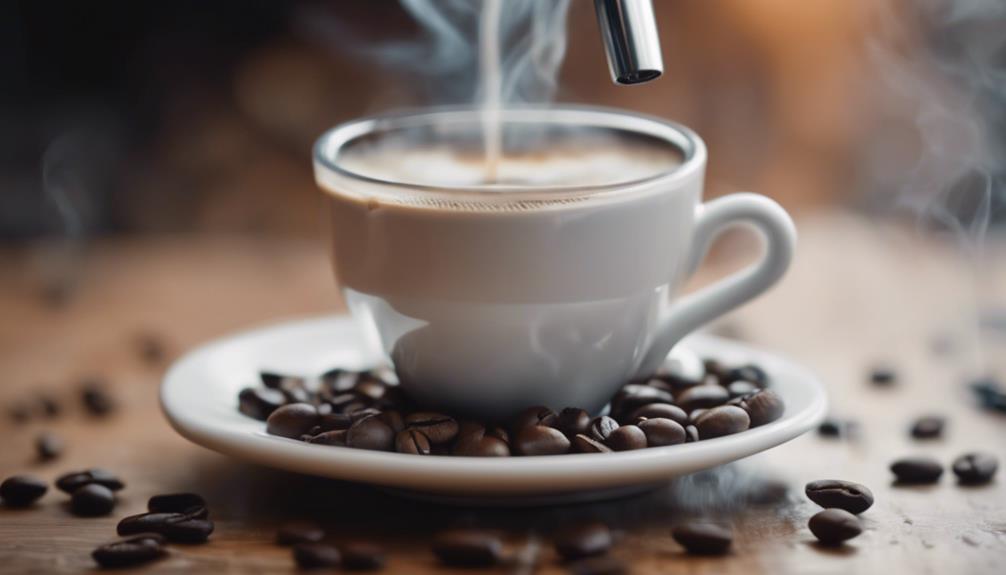
Espresso packs a punch with around 63 mg of caffeine in a single 1-ounce shot. This concentrated coffee beverage is renowned for its robust flavor and high caffeine content, making it a favorite among coffee aficionados. The precise caffeine content can vary slightly based on the coffee beans and the brewing process used, but the general rule remains consistent: espresso delivers a potent dose of caffeine in a small package.
When you savor an espresso shot, you're consuming a concentrated form of coffee that stands apart from regular brewed coffee due to its higher concentration of caffeine. Here are some key points about espresso:
- Caffeine Content: A single shot (1 ounce) contains about 63 milligrams of caffeine.
- Double Shot: If you opt for a double shot, your caffeine intake doubles to approximately 126 milligrams.
- Brewing Process: The method of brewing espresso involves forcing hot water through finely-ground coffee beans, resulting in a potent and flavorful shot.
Understanding the caffeine content in espresso is important, especially if you're mindful of your daily caffeine intake. Given the concentration of caffeine in each shot, it's easy to see why espresso is a popular choice for those seeking a quick, powerful boost.
Espresso-Based Drinks
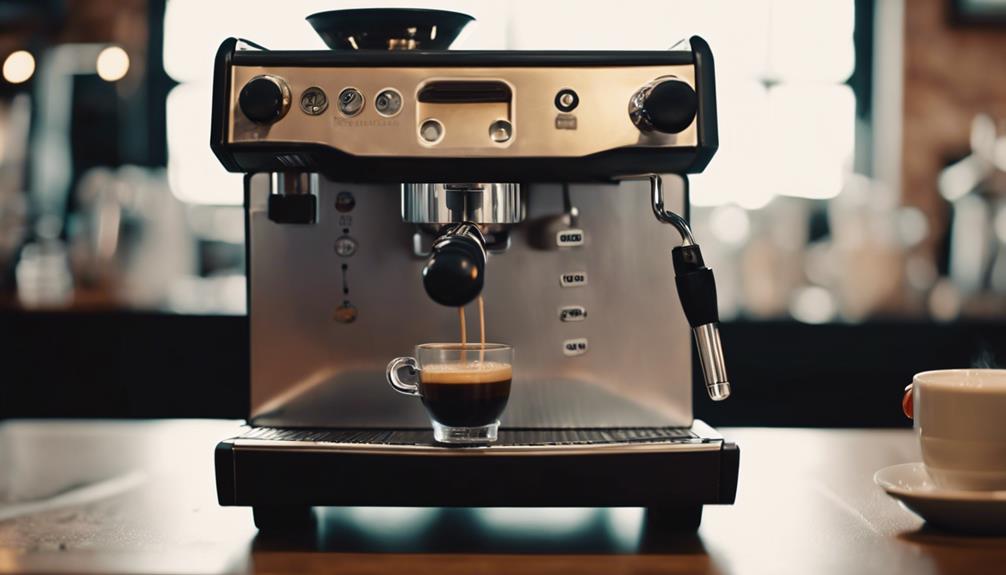
When you're considering espresso-based drinks, it's important to understand how the number of espresso shots impacts the caffeine content.
For instance, a latte or cappuccino typically includes one or more shots of espresso, affecting the overall caffeine intake.
Additionally, drinks like macchiatos also contain varying amounts of caffeine depending on the espresso used, highlighting the importance of knowing these differences for managing your caffeine consumption.
Espresso Shot Caffeine Content
Delving into espresso shot caffeine content, you'll find that a single one-ounce serving typically packs around 63 mg of caffeine. This concentrated dose is a hallmark of espresso-based drinks, which are designed for exploring the immediate energy lift provided by caffeine. Espresso contains a higher caffeine concentration per ounce compared to regular coffee, making it a popular choice for those seeking an immediate energy boost.
Espresso shots are the foundation of many coffee beverages, and understanding their caffeine levels is essential. A standard one-ounce serving of espresso contains 63 mg of caffeine, which can be adjusted based on the number of shots used in a drink. For instance, a double shot espresso will naturally double the caffeine content to approximately 126 mg.
Here are some key points to explore about caffeine in espresso:
- Consistency: A standard serving of espresso is typically 1.5 to 2 ounces, ensuring a predictable caffeine content.
- Customization: The caffeine levels in espresso-based drinks can be tailored by varying the number of espresso shots.
- Efficiency: Espresso shots offer a concentrated caffeine boost, ideal for those needing quick energy.
Latte Vs. Cappuccino
Choosing between a latte and a cappuccino often comes down to personal preference and the desired caffeine kick. Both of these traditional drinks are espresso-based, but they differ noticeably in their milk ratio and caffeine content.
A 12 oz serving of a latte contains around 77 mg of caffeine, while a cappuccino of the same size packs approximately 154 mg of caffeine. This difference arises from the espresso-to-milk ratio used in each drink.
Lattes have a higher milk to espresso ratio, which dilutes the caffeine content, resulting in a smoother, creamier beverage with less caffeine.
On the other hand, cappuccinos have a more balanced ratio of milk to espresso, typically comprising equal parts espresso, steamed milk, and milk foam. This combination results in a stronger taste and higher caffeine content compared to a latte.
Caffeine in Macchiato
A macchiato, with its single shot of espresso, delivers around 63 mg of caffeine in a small yet potent serving. This concentrated coffee drink offers a robust flavor, making it a favorite for those who appreciate a stronger coffee profile without a large volume of liquid.
The caffeine content in a macchiato is relatively moderate compared to other espresso-based beverages like lattes or cappuccinos, which often contain multiple shots of espresso. The serving size of a macchiato is typically smaller, resulting in a concentrated caffeine level that provides a noticeable but not overwhelming kick.
Here are a few key points to consider:
- Caffeine Content: A traditional macchiato has about 63 mg of caffeine, based on a single shot of espresso.
- Serving Size: The small serving size contributes to its strong, concentrated coffee flavor.
- Moderate Kick: While lower in caffeine than larger drinks, it still offers a moderate kick suitable for a quick energy boost.
Understanding the caffeine level in a macchiato can help you choose the right coffee drink to match your preferences and caffeine tolerance. This knowledge allows you to enjoy your coffee without unintended spikes in your caffeine intake.
Instant Coffee
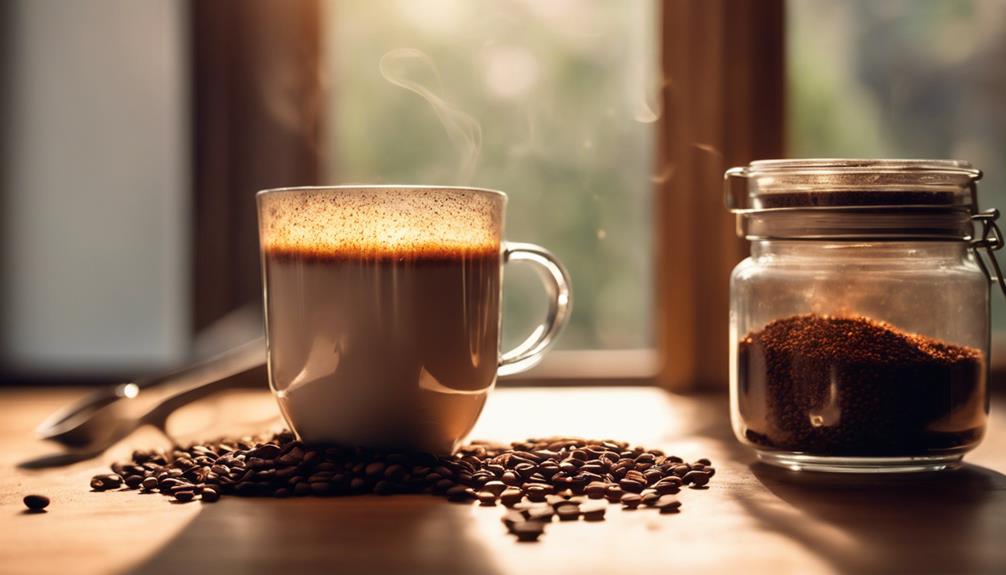
When you're in a rush, instant coffee offers a quick and convenient caffeine boost with its varying content of 30-90 mg per 8 oz cup. This makes it an attractive option for those seeking a moderate caffeine content without the need for elaborate brewing methods.
The caffeine levels in instant coffee can vary greatly, influenced by the amount of coffee powder used during preparation. This variability allows you to control your caffeine intake more easily, tailoring it to your specific needs.
Instant coffee is known for its convenient preparation, making it a popular choice for busy individuals. Simply adding hot water to the coffee powder provides a quick caffeine boost, ideal for those on the go.
The varying caffeine content in instant coffee depends largely on the brand and the specific product, so checking the label is crucial if you're monitoring your intake. Despite its convenience, instant coffee generally offers moderate caffeine levels compared to other coffee types.
Decaf Coffee
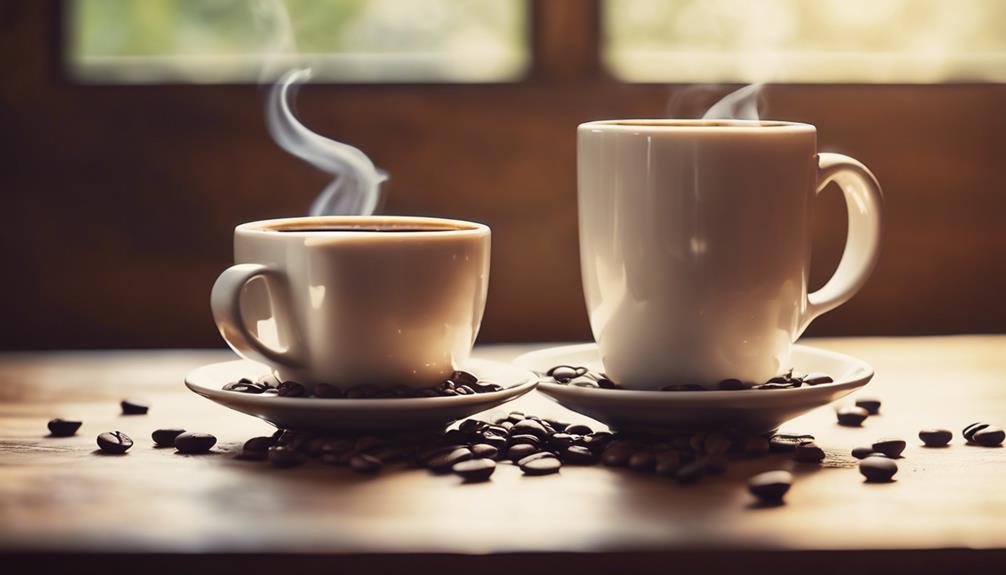
When it comes to decaf coffee, you might be surprised to learn that it still contains a small amount of caffeine, typically around 2 mg per 8-ounce cup.
The decaffeination process aims to remove at least 97% of the caffeine, with methods like the Swiss Water® process achieving up to 99.9% removal.
Understanding these caffeine content levels, along with the decaffeination methods, can help you make informed choices about your coffee consumption, especially if you're considering health implications.
Caffeine Content Levels
Despite being labeled as decaffeinated, decaf coffee still contains a small amount of caffeine, typically around 2 mg per cup. This is a far cry from the caffeine content found in regular coffee, but it's worth mentioning that it's not entirely caffeine-free.
The FDA regulations require that at least 97% of the caffeine be removed for a coffee to be classified as decaf. However, the actual caffeine levels can vary slightly depending on the brand and method used for decaffeination, such as the Swiss Water process, which can remove up to 99.9% of caffeine.
For those monitoring their caffeine intake and aiming to stay within recommended caffeine per day limits, understanding the caffeine amount in decaf coffee becomes important. Here are some key points to keep in mind:
- Caffeine Content: Decaf coffee typically contains about 2 mg of caffeine per cup.
- FDA Regulations: At least 97% of caffeine must be removed for decaf designation.
- Swiss Water Method: This method can achieve up to 99.9% caffeine removal.
Decaf coffee offers a lower-caffeine alternative for those who still want to enjoy the rich flavors of coffee without significantly increasing their caffeine levels.
Decaffeination Process Overview
Decaf coffee undergoes a specialized decaffeination process to remove the majority of its caffeine content. This process typically removes 97-98% of the caffeine from coffee beans. One widely recognized method, the Swiss Water® method, can eliminate up to 99.9% of caffeine. By FDA regulations, for coffee to be labeled as decaf, at least 97% of its caffeine must be removed.
Despite the extensive caffeine removal, decaf coffee isn't entirely caffeine-free. A typical cup of decaf coffee still contains around 2 mg of caffeine, compared to the 95 mg found in a regular cup. The exact caffeine content in decaf coffee can vary depending on the processing method used and the brand of coffee.
For instance, some brands may have slightly higher or lower caffeine levels due to differences in their decaffeination processes. Understanding these nuances helps you make informed choices about your caffeine intake. Whether you prefer the Swiss Water® method or another processing method, knowing that even decaf coffee contains trace amounts of caffeine is essential.
The variability by brand further emphasizes the importance of checking labels if you're particularly sensitive to caffeine.
Health Benefits Considerations
Considering your caffeine sensitivity, decaf coffee offers several health benefits while still providing essential antioxidants and flavor compounds. Decaf coffee is an excellent option for those who need to monitor their caffeine intake due to health reasons or personal preference.
The decaffeination process can remove up to 97-99.9% of caffeine from coffee beans, ensuring that the caffeine content is greatly reduced, typically containing about 2 mg of caffeine per 8-ounce cup.
Decaf coffee retains many of the antioxidants found in regular coffee, which can contribute to overall health. These antioxidants can help in reducing inflammation and protecting against various diseases. Additionally, the flavor compounds, while slightly altered through the decaffeination process, still provide a satisfying coffee experience.
Here are some specific health benefits associated with decaf coffee:
- Reduced Risk of Heart Disease: Studies suggest that decaf coffee may lower the risk of heart disease by improving endothelial function.
- Lowered Risk of Type 2 Diabetes: Decaf coffee has been linked to a reduced risk of developing type 2 diabetes.
- Enhanced Liver Health: Regular consumption of decaf coffee may support liver health and reduce the risk of liver diseases.
According to FDA regulations, for coffee to be labeled as decaf, it must have at least 97% of its caffeine removed, making it a safer choice for those sensitive to caffeine.
Popular Coffee Chains
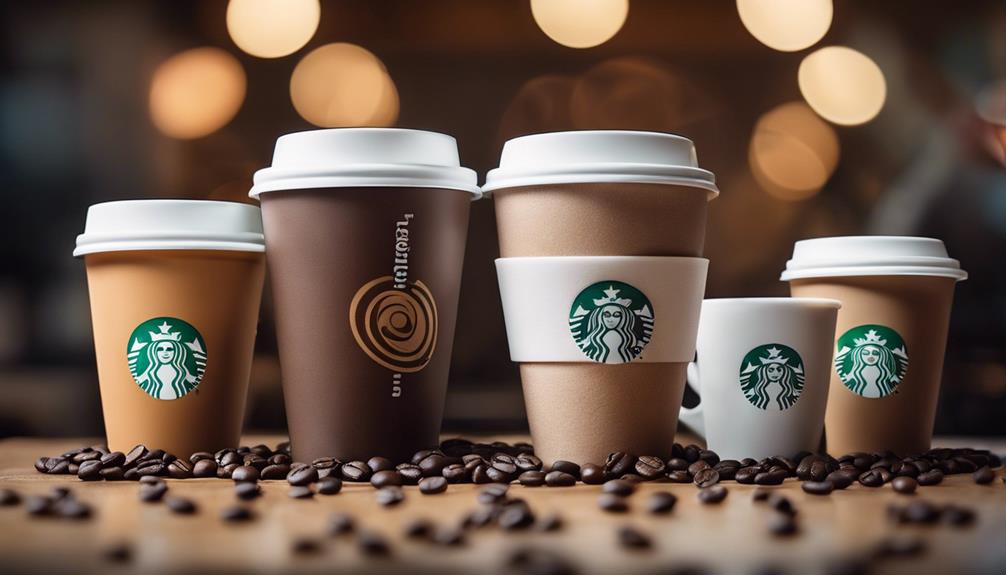
When selecting a coffee chain like Starbucks, McDonald's, or Dunkin Donuts, it's important to take into account the varying caffeine content in their beverages. At Starbucks, the caffeine content ranges from 180 to 415 mg per cup, depending on the size and type of coffee you choose. This variability is influenced by factors such as the number of espresso shots and the specific coffee blend used.
McDonald's offers a range of caffeine content in its coffee, which also varies based on cup size and the type of coffee ordered. Dunkin Donuts provides another option, with caffeine levels ranging from 215 to 517 mg per cup, depending on size and blend.
For a quick caffeine boost, espresso shots typically contain around 63 mg of caffeine. If you're looking to reduce your caffeine intake, decaf coffee is a suitable option as it averages only 0-7 mg of caffeine per cup. By understanding the caffeine content in your favorite coffee chain's offerings, you can better manage your caffeine intake and make informed choices about what to drink based on your personal preferences and tolerance levels.
Factors Influencing Caffeine Content
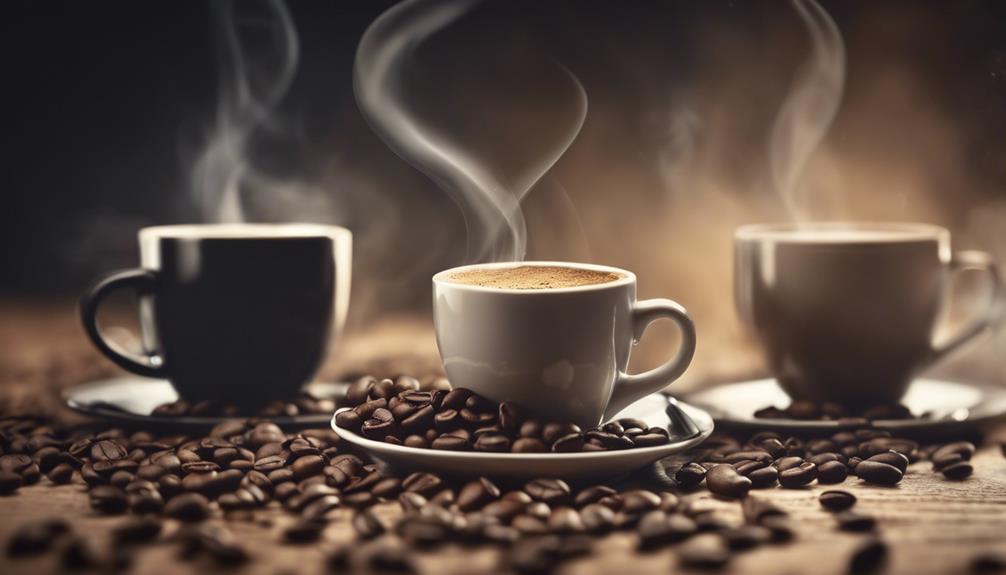
Understanding the factors influencing caffeine content helps you make more informed decisions about your coffee consumption. The amount of caffeine in your cup can vary substantially based on several elements.
Here's a closer look at what affects caffeine concentration:
- Type of coffee bean: Arabica and Robusta are the two primary types of coffee beans. Arabica beans generally contain less caffeine compared to Robusta beans, which have nearly double the caffeine content.
- Roast level: The roast of the beans, whether light or dark, also impacts the caffeine levels. Contrary to popular belief, lighter roasts usually retain more caffeine than darker roasts, as the roasting process gradually reduces caffeine content.
- Brewing method and grind size: Different brewing methods, like using a French press or an espresso machine, extract varying amounts of caffeine. The grind size, whether fine or coarse, influences the extraction process, thereby affecting the caffeine concentration in your cup.
Additionally, the serving size you choose plays a significant role in your total caffeine intake. A standard 8 oz cup will have a different amount of caffeine compared to a smaller espresso shot.
Making Informed Choices
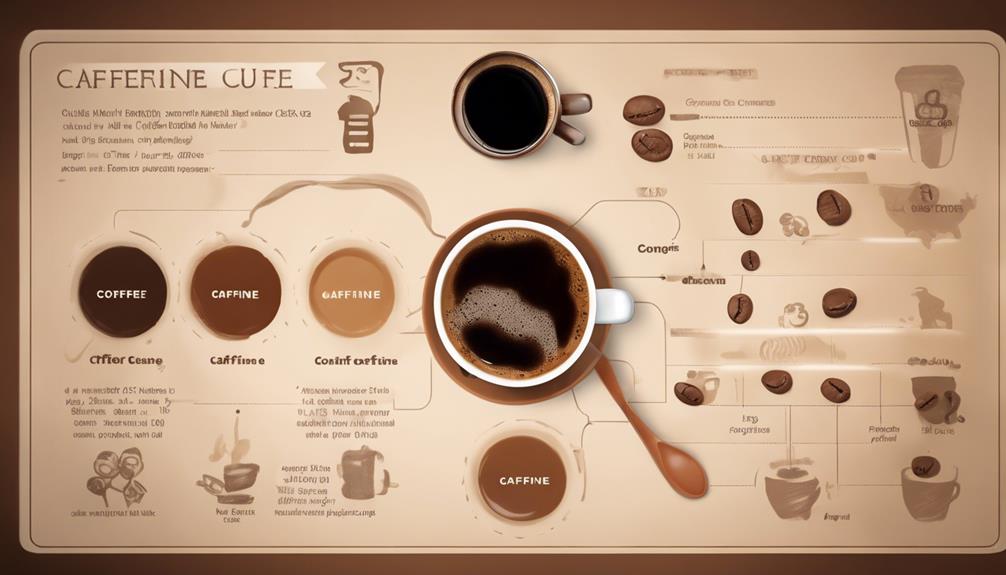
With a clearer grasp of what influences caffeine content, you can now make more informed choices about your coffee consumption. Knowing the caffeine levels in different coffee types helps you tailor your intake according to your tolerance levels and daily routine.
For instance, an 8 oz cup of brewed coffee typically contains 70 to 140 mg of caffeine, while a one-ounce espresso shot has about 63 mg.
If your daily routine requires a quick caffeine boost, opting for an espresso shot might be more effective. On the other hand, if you prefer a longer, more leisurely coffee experience with moderate caffeine, brewed coffee is a suitable choice.
Instant coffee, with its caffeine content ranging from 30 to 90 mg per cup, offers a middle ground, catering to those who need flexibility in their caffeine intake.
For those who are sensitive to caffeine or prefer to limit their intake, decaf coffee is a viable option, containing only 0 to 7 mg of caffeine per cup on average.
Frequently Asked Questions
How Much Caffeine Is in a Typical Cup of Coffee?
In addressing the question of how much caffeine is in a typical cup of coffee, you should note that an 8 oz cup of brewed coffee generally contains around 95 mg of caffeine.
This amount can vary based on factors such as the type of coffee beans used, the roast level, and the brewing method.
For instance, espresso has approximately 63 mg per 1 oz shot, while instant coffee provides about 62 mg per 8 oz cup.
How Much Caffeine Is in Coffee Chart?
Imagine your coffee cup as a treasure chest, the caffeine within varying like hidden jewels.
A coffee chart helps you reveal these secrets: an 8 oz brewed coffee holds 70-140 mg of caffeine, while a shot of espresso contains about 63 mg.
Instant coffee ranges from 30-90 mg per cup, and decaf offers 0-7 mg.
Different types and serving sizes impact this, so use a chart for precise information.
How Much Caffeine Is in a 12 Oz Cup of Black Coffee?
In a 12 oz cup of black coffee, you'll typically find around 154 mg of caffeine. However, this amount can vary depending on factors like the type of coffee beans used, the roast level, and the brewing method.
Understanding this variability is essential for effectively managing your daily caffeine intake. Black coffee remains a favored option for those seeking a straightforward, low-calorie caffeine boost.
Is 200 Mg of Caffeine a Lot?
Imagine caffeine as a double-edged sword; 200 mg is generally considered moderate and safe for most adults, akin to two cups of brewed coffee or four shots of espresso. This amount can increase your alertness and energy without breaching recommended limits.
However, individual tolerance varies, so while it's not excessive, you should monitor other caffeine sources to avoid exceeding safe daily limits.
What Is the Average Caffeine Content in a Cup of Coffee?
The detailed caffeine content in coffee can vary depending on factors such as bean type, roast level, and brewing method. On average, an 8-ounce cup of coffee contains around 95 milligrams of caffeine. However, this can range from 70 to 140 milligrams depending on the variables mentioned. Some types of brews, such as cold brew, can contain higher levels of caffeine due to their longer brewing process, while espresso typically contains less caffeine per serving despite its stronger flavor. If you are looking to limit your caffeine intake, it’s important to be aware of the factors that can affect the caffeine content in your coffee and adjust your brewing methods accordingly.
Conclusion
In conclusion, the caffeine content in your cup of coffee varies greatly depending on the type. For example, a standard 8-ounce cup of brewed coffee typically contains about 95 mg of caffeine.
Surprisingly, espresso packs a punch with around 63 mg in just a 1-ounce shot.
By understanding these differences and the factors influencing caffeine content, you can make more informed choices tailored to your preferences and caffeine tolerance, ensuring a satisfying and balanced coffee experience.
